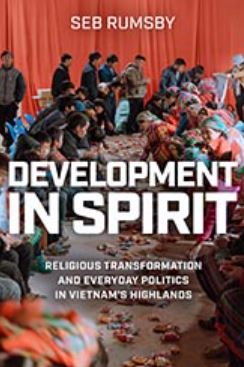The book Rivers of Iron: Railroads and Chinese Power in Southeast Asia by David M. Lampton, Selina Ho, and Cheng-Chwee Kuik is a timely and ambitious endeavor to make sense of the enduring allure and multifaceted challenges of enhancing cross-border connectivity through a Pan-Asian railway and of implementing the grand vision of BRI. The authors reveal how railroad projects are negotiated among actors with diverse interests and stakes in connectivity in both China and Southeast Asian countries, writes Kathrin Reed
_______________________________________________
The Chinese moto “if you want to get rich, first build roads” (要想富, 先修路) highlights the centrality and appeal of large infrastructure projects to the Chinese development approach at home and abroad, especially in neighboring Southeast Asia. In December 2021, the Chinese and Lao governments inaugurated a flagship component of the Belt and Road Initiative (BRI), a high-speed railroad connecting Yunnan province in China with the border of Laos and Thailand near the capital of Vientiane. A few weeks earlier, the United Nations General Assembly approved Laos to graduate from its status as a least developed country in 2026.
 On the one hand, this can be conceived of as a monumental achievement for this landlocked country and for narrowing the development gap between mainland and maritime Southeast Asia, a major objective of the Association of Southeast Asian Nations. On the other hand, it has involved displacing thousands of local farmers and significantly indebting this small state to China. Therefore, the book Rivers of Iron: Railroads and Chinese Power in Southeast Asia is a timely and ambitious endeavor to make sense of the enduring allure and multifaceted challenges of enhancing cross-border connectivity through a Pan-Asian railway and of implementing the grand vision of BRI. The multinational research team conducted interviews and field visits to eight countries across multiple years, involving the participation of over 150 organisations.
On the one hand, this can be conceived of as a monumental achievement for this landlocked country and for narrowing the development gap between mainland and maritime Southeast Asia, a major objective of the Association of Southeast Asian Nations. On the other hand, it has involved displacing thousands of local farmers and significantly indebting this small state to China. Therefore, the book Rivers of Iron: Railroads and Chinese Power in Southeast Asia is a timely and ambitious endeavor to make sense of the enduring allure and multifaceted challenges of enhancing cross-border connectivity through a Pan-Asian railway and of implementing the grand vision of BRI. The multinational research team conducted interviews and field visits to eight countries across multiple years, involving the participation of over 150 organisations.
David Lampton, Selina Ho, and Cheng Chwee-Kuik reveal how railroad projects are continuously contested and negotiated among actors with diverse interests and stakes in connectivity at the national, sub-national and local levels in both China and Southeast Asian countries. The book touches upon four core areas of social science research: power in asymmetrical relationships, negotiation tactics, the role of domestic politics in shaping foreign policy behavior, and policy implementation.
The authors provide an agency-centric and process-oriented account of infrastructure development in the region, importantly complicating the conventional narrative of China as a monolithic actor with absolute power vis-à-vis the smaller states in Southeast Asia.
The second chapter traces the history of railroad development in Southeast Asia, as well as in China. In the post-World War II period, the authors emphasise that members of ASEAN were the conductors of the Pan-Asian railway dream until rapid socio-economic and technological development in China aligned their interests and sped up the process. Other factors such as global political and financial shocks, decolonisation, support from leadership and a domestic audience, and domestic demand for railroads proved as enabling and disabling conditions for railroad development from the 19th century onwards. In particular, ministerial leadership in China was decisive in pushing for railroad development at home and abroad in the 2000s.
Yet, the third chapter suggests that exporting the infrastructure vision to Southeast Asia is challenging for a country with decentralised development practices and competing ideas about the role of BRI in foreign policy. In offering a detailed account of the two main societal and expert-level debates on BRI in China, the authors demonstrate the internal contestation of infrastructure development abroad and lack of uniformity in implementing the vision. This is further complicated when taking into account the diverse responses of Southeast Asian states to BRI, considered in the fourth chapter. The varied development levels, domestic political systems and regime legitimation pathways of Southeast Asian states influence China’s capacity to implement large railroad projects.
According to the authors, the interplay of these variables has produced divergent responses in the examined case studies: selective and flexible engagement (Thailand), receptive engagement (Malaysia), limited involvement (Vietnam), and enthusiastic but gradual embrace (Laos). This is the context in which China and smaller Southeast Asian states are negotiating, which is explored in the fifth chapter. Engaging with the growing literature on the agency of smaller states, the authors address the role of power asymmetry beyond the security realm. Notably, the bargaining power of smaller states is based on relative size and wealth, geographic location, state capacity, and public opinion in the domestic realm.
Given the aligned interests on infrastructure development between China and its Southern neighbors, the Chinese government is implementing a strategy of expressive hierarchy whereby it exercises restraint in negotiations.
As the sixth chapter argues, this bargaining process continues during the implementation phases, in which local actors and interests take centre stage and risk delaying or even derailing projects. The initial stage of land acquisition and clearance proves especially difficult due to the impact of domestic politics in Southeast Asia and the lack of experience with private land on the part of Chinese actors. Since 2014, the Chinese government additionally has contended with geopolitical competition in infrastructure development, which is presented in the seventh chapter. With its focus on quality infrastructure and the local economy, Japan has particularly emerged as an alternative player in railroad development. Nevertheless, the leverage that Southeast Asian states gain through alternative partners depends on the specific terms that they can offer and the willingness of China to learn from its past mistakes in the region.
The concluding chapter highlights the contingent nature of BRI on domestic politics and development in China and implores the American government to consider the role of infrastructure in its own development and foreign policy, advocating for a “balanced connectivity” approach that does not focus on China. It importantly reminds us that strategic economic and political competition is taking place amongst Southeast Asian countries and not just between the great powers. Given the focus on the smaller states, this observation would have been interesting to explore earlier on in the book, especially since it adds a critical layer of complexity to negotiating a pan-Asian railroad with multiple countries. Nevertheless, this may outside the scope of the book as it would move the conversation beyond the link between domestic politics and foreign policy.
Overall, the interplay between China exercising restraint and smaller states exerting their agency could have been addressed more deeply. The idea that smaller states are not helpless even in asymmetrical power relations, such as between China and Southeast Asian states, is not new. How much space for exerting their agency do smaller states have in China’s expressive hierarchy? How much of this space is a result of structural conditions rather than as a function of agency? In this regard, the discussion could have been linked to the literature on railroad negotiations in Southeast Asia, such as Yoon Ah Oh’s article on bargaining.
There is a clear trade-off between examining the general drivers and challenges of connectivity through BRI and in-depth analysis of the railroad negotiation case studies in Southeast Asia. For example, it would have been informative to provide a more detailed example of a Chinese debate on a specific railroad project in Southeast Asia in the third chapter. Moreover, with the exception of the second chapter, little attention is paid to contemporary debates within ASEAN on the pan-Asian railroad or to how membership in ASEAN or other sub-regional organisations such as the Greater Mekong Sub-region may impact how smaller states are negotiating with China on infrastructure projects.
However, these are questions that arise from the impressive breadth and value-added of the book and that can be further explored in future publications on this pivotal topic. The heightened competition on infrastructure development in Southeast Asia is especially visible in Phnom Penh, where signs from the Chinese, Japanese and now also increasingly the South Korean governments abound.
______________________________________________
* This book review is published by the LSE Southeast Asia blog and LSE Review of Books blog as part of a collaborative series focusing on timely and important social science books from and about Southeast Asia.
* Banner photo front cover of Rivers of Iron: Railroads and Chinese Power in Southeast Asia by by David M. Lampton, Selina Ho, and Cheng-Chwee Kuik
*The views expressed in the blog are those of the author alone. They do not reflect the position of the Saw Swee Hock Southeast Asia Centre, nor that of the London School of Economics and Political Science.





